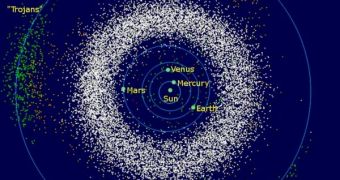Recent observations of the asteroid belt around the inner planets have led astronomers to believe that the group of celestial bodies still bears the “scars” of its encounter with Jupiter and Saturn, which left their original orbit billions of years ago, when the solar system was first created. According to astrophysicists, the two giant planets moved away from the Sun in the early days, when things in the solar system were pretty hectic, and into a more distant orbit, where they still are today.
Astronomers hope that, by studying possible traces of the two planets' passing through the belt, they will be able to learn exactly how long ago this happened, as well as the original orbital coordinates from which the planets moved.
Computer models of the first two billion years after the formation of our solar system show that Jupiter, Saturn, Uranus, and Neptune were most likely “born” closely together. In time, interactions with the asteroid belts forced a change in their trajectories, and the four celestial bodies moved further apart, and into their final orbits.
A theory has it that the meteors and asteroids that were displaced might have been the ones responsible for the battering that Earth, Mars, the Moon and Venus underwent about 3.8 billion years ago, which left them with the scars visible today.
Also, the passing might have influenced the formation of the main asteroid belt between Mars and Jupiter, which might have looked completely different billions of years ago. Although theories on what happened abound, there is no way of telling for sure what events the four planets triggered during their “migration” and what influence they had on the belt.
The things that have led scientists to believe that the planets still left their marks on the asteroids in the belt are the gaps that exist on various portions of it. They may have very well been generated by Jupiter's gravity, which is known for making celestial objects behave erratically. In addition, the moons of Saturn create the same effects in the planet's dust rings, which can be considered as a strong argument in favor of this theory.
Astronomers are currently gathering all the data they can on the asteroid belt and the possible trajectories of the four large planets, in order to construct a computer simulation that will hopefully provide them with insight into the early origins of the solar system. Finding out what happened to them could shed some light on the current configuration of the planets, and may explain meteor and asteroid holes in our neighbors.

 14 DAY TRIAL //
14 DAY TRIAL //